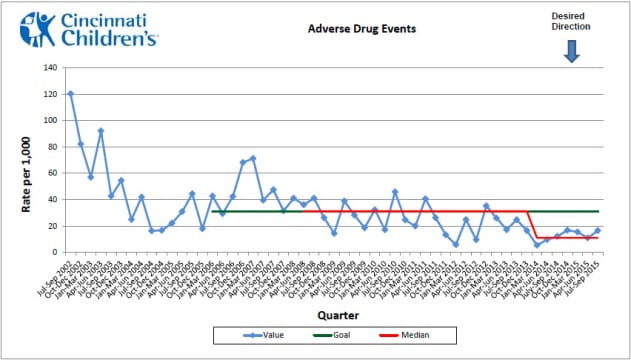Adverse Drug Events (ADEs)
Why This Measure is Important
The Staff at Cincinnati Children's Hospital Medical Center are committed to reducing the number of adverse drug events (ADEs). Children pose special challenges in the drug ordering and delivery process because most medication doses are ordered by the weight of the child. Ongoing monitoring of our performance in this area is key to providing safe and effective quality care.
How we measure:
A trigger tool methodology is used to perform monthly reviews of a sample of patient charts. This tool uses a number of care activities or “triggers” that if found, results in additional review to determine if an adverse event has taken place. Adverse drug events are divided by the number of days patients in the sample are hospitalized and are multiplied by 1,000.

Click here to view a larger version of the chart in PDF format.
What we are doing to improve:
- Cincinnati Children’s uses Computerized Physician Order Entry (CPOE) and electronic automated detection as ways to decrease the likelihood that adverse drug events will occur.
- Cincinnati Children's participates in the Ohio Childrens’ Hospitals Solutions for Patient Safety (SPS) project http://www.solutionsforpatientsafety.org/. This project uses a collaborative model and data sharing to create learning opportunities and accelerate improvement.
- Cincinnati Children's monitors the use of various medications to understand the potential for adverse drug events. Information gained from this monitoring provides data necessary to develop proactive measures to prevent adverse drug events.
- Data on adverse drug events and methods for preventing them are reviewed and acted upon by an established improvement team. Through this group, trends are identified and prioritized for further action.
View the Operational Definition: Adverse Drug Events (ADEs)



